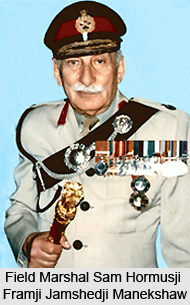 Sam Hormusji Framji Jamshedji Manekshaw was born on April 3, 1914 at Amritsar in Punjab.He belonged to a Parsi family.In his childhood he was educated at Amritsar and then received education from Sherwood College ,Nainital. Sam Hormusji Framji Jamshedji Manekshaw attended the first batch Indian Military Academy in Dehradun in 1932.After completing education from IMC Sam Hormusji Framji Jamshedji Manekshaw was commissioned into the 12 FF Rifles of the Indian Army as a second Lieutenant.
Sam Hormusji Framji Jamshedji Manekshaw served Indian Army for over 40years and fought five wars including the World War II.At first he was posted to the Royal Scots and then he was transferred to 4/12 Frontier Force Regiment.During that time he saw the first Burma campaign on the Sittang river. As captain, Sam Hormusji Framji Jamshedji Manekshaw fought bravely against Japanese army. Despite being wounded He led a counter attack against evading Japanese army in Burma. For his courage and firmness he was awarded the Military Cross (MC) and was sent to India due to his serious health condition.
Sam Hormusji Framji Jamshedji Manekshaw was born on April 3, 1914 at Amritsar in Punjab.He belonged to a Parsi family.In his childhood he was educated at Amritsar and then received education from Sherwood College ,Nainital. Sam Hormusji Framji Jamshedji Manekshaw attended the first batch Indian Military Academy in Dehradun in 1932.After completing education from IMC Sam Hormusji Framji Jamshedji Manekshaw was commissioned into the 12 FF Rifles of the Indian Army as a second Lieutenant.
Sam Hormusji Framji Jamshedji Manekshaw served Indian Army for over 40years and fought five wars including the World War II.At first he was posted to the Royal Scots and then he was transferred to 4/12 Frontier Force Regiment.During that time he saw the first Burma campaign on the Sittang river. As captain, Sam Hormusji Framji Jamshedji Manekshaw fought bravely against Japanese army. Despite being wounded He led a counter attack against evading Japanese army in Burma. For his courage and firmness he was awarded the Military Cross (MC) and was sent to India due to his serious health condition.
After recovery Sam Hormusji Framji Jamshedji Manekshaw atteneded a course at Staff College, Quetta and subsequentely appointed instructor there.After a few days he came back to India and joined to the12 Frontier Force Rifles in Burma under General (later Field Marshal) Slim`s 14th Army.Again Sam Hormusji Framji Jamshedji Manekshaw fought against Japanese army with great tenacity but wounded again for the second time and was sent to India.At the end of Japanese surrender in the World War II he was appointed as a staff officer to rehabilitate over 10,000 Prisoners Of Wars.In 1946 he moved to Australia on six lecture tour.After that he was appointed as a First Grade Staff Officer in the Military Operations Directorate.
During the time of partition Sam Hormusji Framji Jamshedji Manekshaw showed his skill for planning and administration and tackled the partition related issues with great persistence.He also led his troops courageously in the battle during Jammu& Kashmir operation in 1947.After that Sam Hormusji Framji Jamshedji Manekshaw held different prestigious posts.He cammandend an Infantry Brigade ,became commander of an Infantry School, served as the Colonel of 8 Gorkha Rifles and 61 cavalry, commanded a Division in Jammu & Kashmir and a Corps in the North East. Sam Hormusji Framji Jamshedji Manekshaw was also the Commandant of Defence Services Staff College (DSSC). He hanldled many crucial problems of insurgency in Nagaland as GOC-in-C Eastern command. For great service to the nation Sam Hormusji Framji Jamshedji Manekshaw was decorated with Padma Bhushan in 1968.
In the year of 1969 Sam Hormusji Framji Jamshedji Manekshaw assumed the charge of 8th Chief of Army Staff ,succeeded General Kumaramangalam.During the war against Pakistan he showed his ability for proper strategy making.Under his leadership India won the war and that followed the formation of Bangladesh.For his dedicated service to the nation he was awarded the Padma Bibhusana in 1962. Sam Hormusji Framji Jamshedji Manekshaw was promoted to the honorary rank of Field Marshal on 1 January 1973.He was the second Indian Army Generals to be awarded this prestigious rank after late Field Marshal Kodandera Madappa Cariappa. Field Marshal Sam Hormusji Framji Jamshedji Manekshaw retired on 15th January 1973.After retirement he was appointed as director of several companies. At present, he is permanently settled down at `Stavka` Spring Field, Porter Avenue, Coonoor near Nilgiri hills in South India.




















